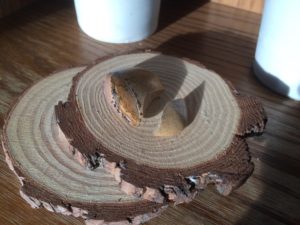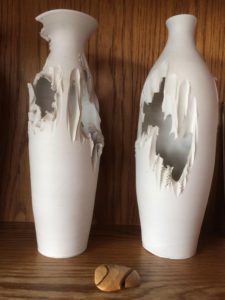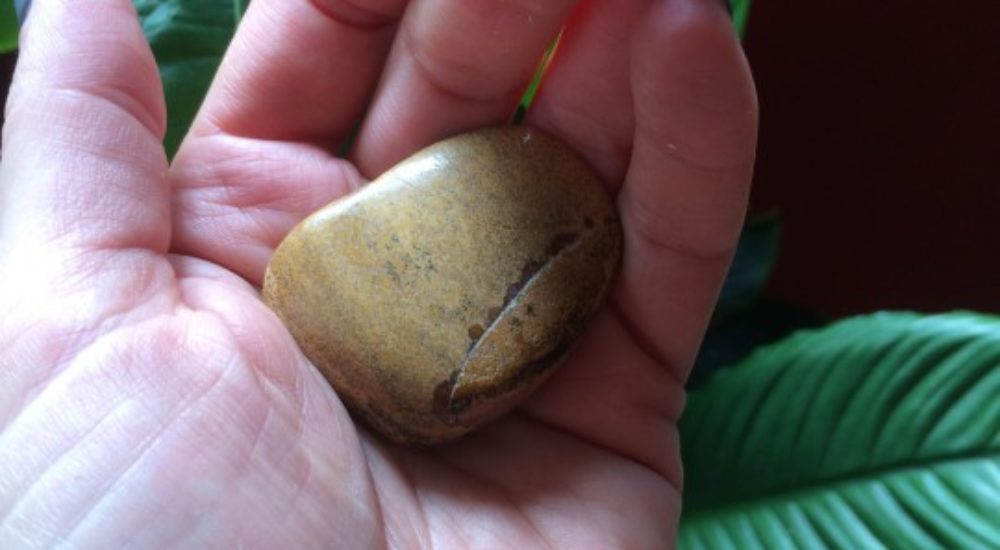Last winter I flew across the country to attend a health equity training with colleagues and, as I sometimes do when I travel, I carried a stone in my pocket that symbolizes for me balance, regulation, and interconnection – a reminder of seeking to join my head and heart space. The stone fit perfectly in the palm of my hand and felt smooth and solid there.
 After two full days of intense learning, reflecting, storytelling, and connecting, I debriefed and discussed with colleagues over dinner. Toward the end of the meal I stood up and the stone fell out of my pocket. It landed on the tile floor and snapped in two – I was alarmed. Stones are breakable?! Trying to read the energy of the situation I said to my colleague, lightly but deflated, “I hope it doesn’t mean anything!” In my hand the two pieces felt jagged and rough. They appeared broken and for many moments everything felt off. But I went about the evening trying not to read into it.
After two full days of intense learning, reflecting, storytelling, and connecting, I debriefed and discussed with colleagues over dinner. Toward the end of the meal I stood up and the stone fell out of my pocket. It landed on the tile floor and snapped in two – I was alarmed. Stones are breakable?! Trying to read the energy of the situation I said to my colleague, lightly but deflated, “I hope it doesn’t mean anything!” In my hand the two pieces felt jagged and rough. They appeared broken and for many moments everything felt off. But I went about the evening trying not to read into it.
In the morning, fresh with new perspective, the thought dawned on me I do take meaning from what happened the night before. The stone that I liked and was accustomed to is more malleable than I thought. True, I don’t have that same stone anymore, but now I have two stones. In addition to regulation and interconnection, their new rough edges can remind me to stay sharp and hold them gently. With two stones I can place one in each hand, or give one to a friend. I found in this moment, as I have throughout life, that broken is beautiful, and offers lessons and new opportunities.
It seemed fitting that this simple event occurred after a deep dive equity training. After sitting at length with the sweeping call to act, to dismantle and redefine systems and structures that we may have assumed, or been told, were whole. Where especially those of us who have benefited from systemic privilege – due to our race, gender, able-body, age, body size, etc. – are called on to recognize our collective brokenness, so that it may be an entry point to healing and repair.
As I reflect on this incident in the midst of our COVID-19 crisis, the brokenness that surrounds us is all too real and concrete.
Our education system has come to a screeching halt and is in the middle of re-inventing itself in real time, with devastating challenges for families and children due to our digital divide, inequitable access to healthy food, and more.
Our health system is strained, overburdened, and underequipped, even as some hospitals have made cuts and laid off those we all need most during this time.
The familiar semblance of our households has fleeted away leaving individuals, families, chosen families, and people who are unhoused reeling in recovery mode.
In sum, we have all been forced into a break from society as we knew it and our mission now, if we choose to accept it, is to rebuild stronger and better together than we were before.
 Many have illustrated how this crisis exposes our society’s long-standing inequities and searing gaps in access to the means for a healthy, productive life. There is nothing shocking or even noteworthy about people with privilege succeeding in life on society’s terms and having positive outcomes in health, education, finances, or employment. Social structures and systems were set up for us and if they don’t work, we jump into action to change them.
Many have illustrated how this crisis exposes our society’s long-standing inequities and searing gaps in access to the means for a healthy, productive life. There is nothing shocking or even noteworthy about people with privilege succeeding in life on society’s terms and having positive outcomes in health, education, finances, or employment. Social structures and systems were set up for us and if they don’t work, we jump into action to change them.
During times of distress, we can come out even stronger by the meaning we make of our experience, and our ability to open to new opportunities. What if we take this break to heart and create the space within ourselves to dream up a better way, and to actually believe it is possible? Now is the time to imagine a different set of assumptions and a more inclusive co-existence by prioritizing all children and those who have been marginalized or oppressed for generations. When I imagine that we may be up for this collective task, this challenge and opportunity become a source of vital energy.
I appreciate that this effort is personal and lives within us, as much as it lives within our shared policies, procedures, and organizational practices in the spaces of work and community. Each of us can learn to catch ourselves in the decisions of everyday life that don’t consider, include, consult, door-open, or otherwise share power with those who are marginalized. Each of us can co-create opportunities to build habits, procedures, and organizational cultures that embrace the other as our own.
While the rupture and disruption we are experiencing is certainly uncomfortable, this hurt may be our prerequisite for change, to be catalyzed into growing pains if we channel these feelings and don’t look away. While this path is difficult and harder to hold than the status quo, the sharp edges of accepting our brokenness moves us further into collective well-being. We must recognize this break for the opening that it is, to bring about a better reality. This is the life-affirming force and choice for all of us.
For breakfast, I had coffee, a sandwich, and a smoothie.
Author: @aresnick
